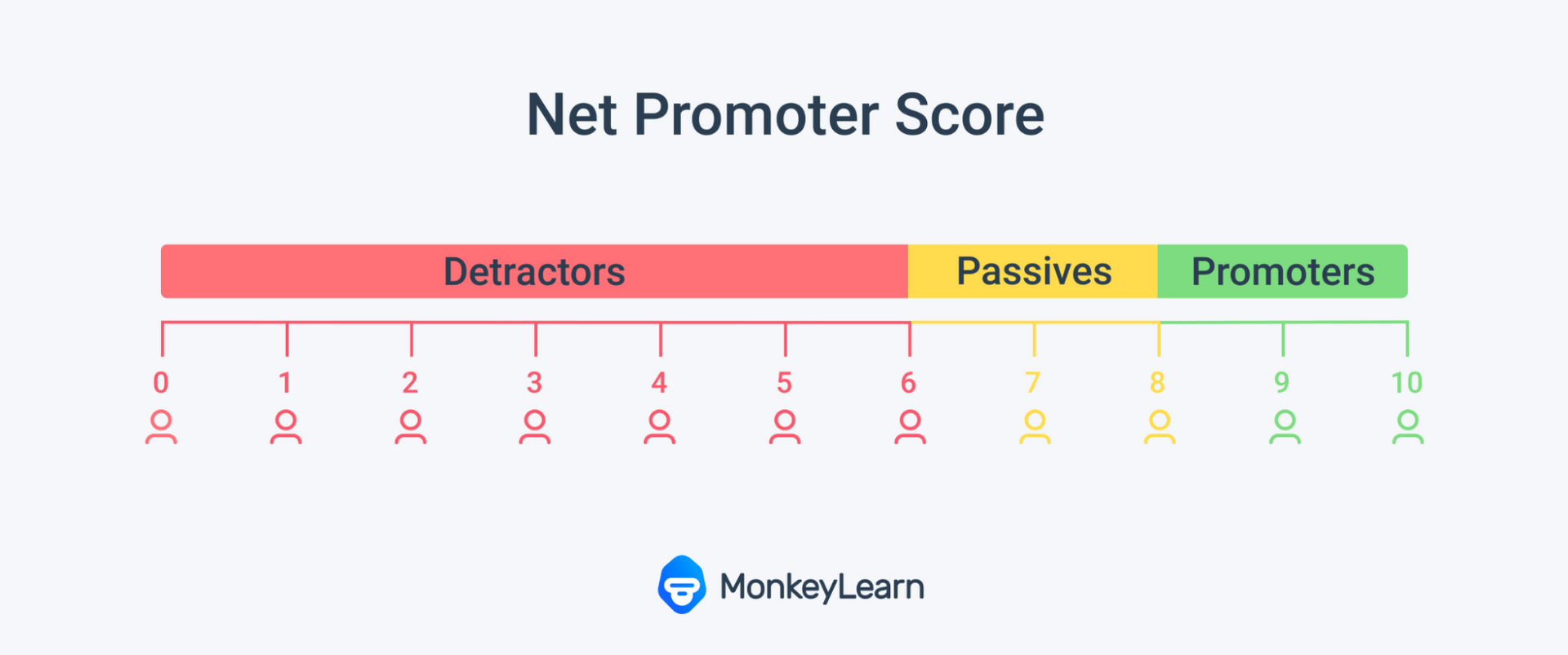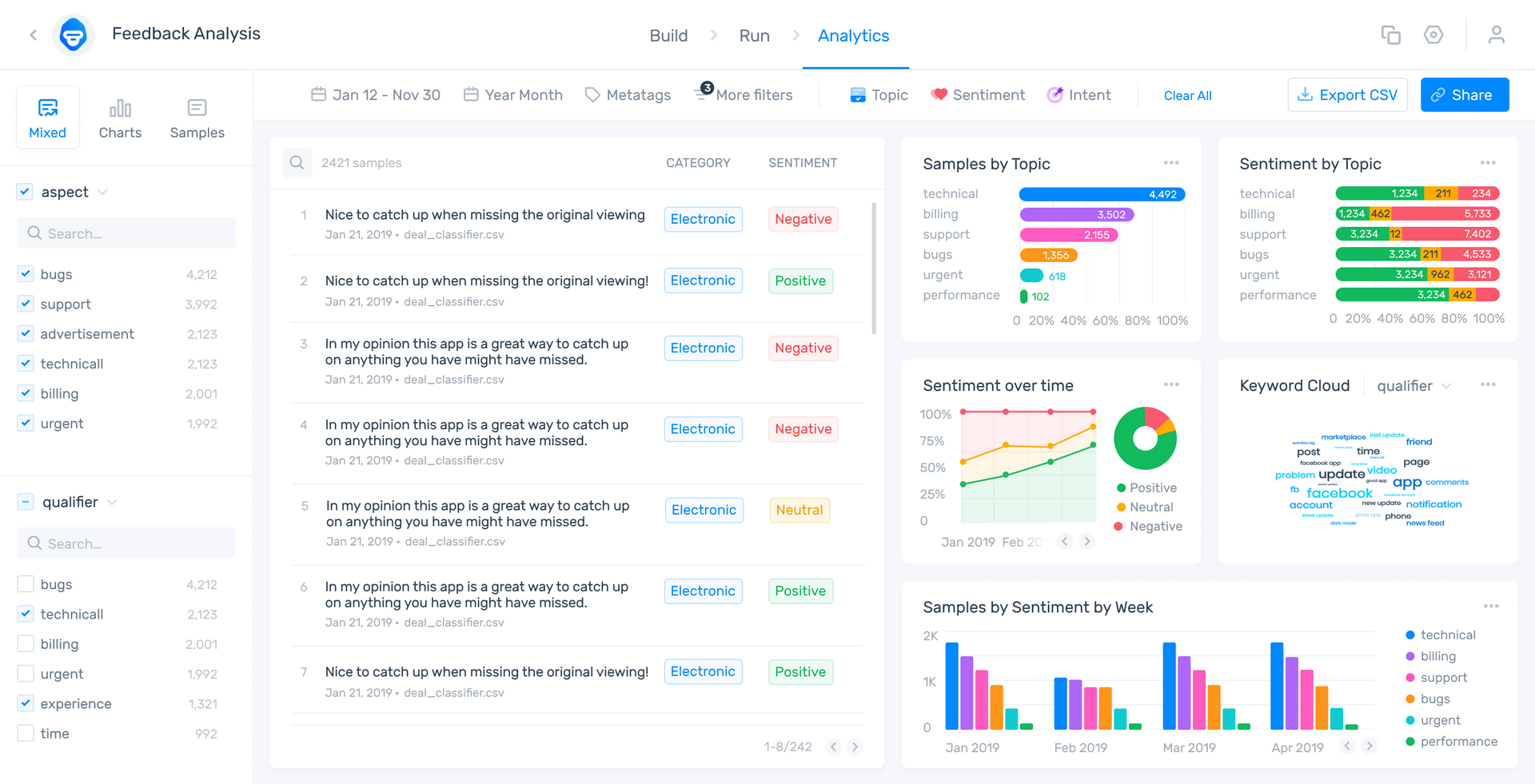Perfecting Net Promoter Score (NPS): Advanced NPS Survey Examples

The value of NPS survey data can’t be understated - your NPS score provides a keen cross-section of overall customer loyalty and business health.
But NPS surveys can, and should, do more.
Whether you’re just starting out and are taking that first step of implementing broad, baseline NPS surveys, or if you are already sending out a number of NPS surveys each with specific aims, you’ll find useful tips in this guide.
Within you’ll find out how to develop an advanced NPS survey analysis approach by asking need-specific close ended questions and targeted, customer type conscious open-ended follow ups.
- What Is a Net Promoter Score (NPS) Survey
- Advanced NPS Survey Examples
- Analyzing Your NPS Results
- Takeaways
What is a Net Promoter Score (NPS) Survey
Your net promoter score is a customer satisfaction metric reflecting how satisfied your customers are. It is essentially a barometer of overall customer loyalty. Here are the basics on how to calculate your close-ended NPS score.
Analyzing your close-ended results starts with asking your customers this question (or a variation thereof, see below):
“On a scale of 0 to 10, how likely are you to recommend our business to a friend or colleague?”
Then you sort your 0-10 responses into three groups: Promoters, detractors, and passives:

- Promoters are those who answered highly favorably (9-10 on the scale)
- Detractors are those who answered relatively negatively (1-6 on the scale)
- Passives are those who answered in between the two (7-8 on the scale)
As you can tell, this scale holds a high standard for promoters. Once you’ve grouped your responses accordingly, you then calculate the percentage of both promoters and detractors within your total number of responses and derive your NPS score using the following equation:

Let’s look at an example of how this works.
Net promoter score example: Take the percentage of promoters minus the percentage of detractors. So, if you have 40% Promoters and 20% Detractors, your NPS score would be 20 (40 - 20 = 20).
NPS surveys are composed of two parts, a close-ended, numeric question, and an open-ended, written addendum.
Let’s take a look at how you can tweak both parts of NPS to better address specific questions you have about your products/services.
Advanced NPS Survey Templates
Within we will explore some useful question templates for types of NPS, which are:
1. Close-ended NPS Question Templates
As we mentioned above, the typical close-ended NPS question is:
“On a scale of 0 to 10, how likely are you to recommend our business to a friend or colleague?”
This is the default format for close-ended NPS because it:
- Is a good icebreaker as it presents a plausible, friendly hypothetical,
- Elicits helpful, overall feedback about the customers total interaction with the brand, and
- Urges the respondent to consider the entirety of their experience, a useful lead-in for the open-ended question to follow.
Personalization is one of NPS survey best practices, here are some examples of how to modify this question to address specific products or services and even employee feedback.
For Specific Products or Services
Looking for a simple trick to change your overall NPS survey insights into product/service-specific insights? Just replace ‘business’ in the generic format with the ‘product/service’ you are looking for feedback on.
So, your question becomes:
“How likely are you to recommend (product/service) to a friend or colleague?”
Just like that you have shifted focus from macro (business-wide) to micro (product-specific).
If you don’t know which customers to ask, you can perform survey analysis on your customer feedback to isolate the customers who have strong feelings about your product/service of choice.
To find these customers, you can use automated text analysis to parse your feedback, extract keywords, and perform sentiment analysis. This will help you determine which customers are most/least passionate about which products.
Then, you can target these polarized customers with the above question (and likely receive a high response rate + passionate responses).
For Employee Feedback
Employee feedback NPS, or eNPS, measures how likely your employees are to recommend working for you to their friends and/or past colleagues.
The reality is that unsatisfied employees have proven unlikely to speak up – rather, they will just leave.
Regularly reaching out for employee feedback and taking action to address any practices that are lowering employee happiness can actively combat this.
Your closed-ended question can be adjusted to:
“How likely are you to recommend (company name) as a potential workplace to your friends?”
By asking this this type of question on a regular basis, and by making employee satisfaction a priority on the whole, you can:
- Prevent employee churn
- Create a happier work environment that will boost customer satisfaction in turn
- Keep team morale high, increasing both commitment to success and overall performance.
2. Open-ended NPS Survey Templates
The boilerplate open-ended NPS survey question is:
“What is the primary reason for your score?”
This is paired with a response box below where a customer can type out their answer, giving customers the opportunity to explain the ‘why’ behind their responses.
These insights can only be accurately and efficiently obtained through automated AI analysis. This analysis can turn vast archives of text responses into quantified, actionable and easily visualized results, saving your teams both time and costly missteps.
Let’s look at three alternative question templates and the kind of responses each might draw:
- For Detractors: “How can we improve your experience?”
- For Promoters: “What would make your experience even better?”
- For Further Research: “What problem did our company/product/service solve?”
1. For Detractors: “How can we improve your experience”
Phrasing your open-ended question like this makes for a useful twist on the standard template if you are looking to eliminate churn by addressing friction points for customers having issues.
There is evidence that if you ask detractors this kind of question (demonstrating that you care about their experience) and then take direct action to resolve it, you can actually transform detractors into vocal advocates.
Furthermore, detractors tend to offer extensive feedback because of their frustration with their experience which can help you address their pain points.
2. For Promoters: “What would make your experience even better?”
Customers who will freely recommend your product to others, aka brand advocates, are of supreme value to your bottom line. They are both loyal and likely to attract others via free, honest, word-of-mouth.
Pushing your ‘promoters’ that final step to being vocal advocates, however, can be difficult.
In order to do so, your teams must remain committed to improving experience as much as possible, even for your satisfied customers. Continuing to ask the above question and attending to the results will help you bridge that final gap and create vocal advocates.
3. For Further Research: “What problem did our company/product/service solve?”
This question is useful for future market research strategy, including the shaping of future customer feedback surveys.
When you probe for the customer intent that originally drew them to your product/service, you gain information on what your target demographic should be. This can then help future advertising and marketing campaigns.
Essentially, by understanding your current customers, you can better attract future customers.
When it comes to being informed, what you do with your new NPS data is equally as important as asking the right questions.
Analyze Your Results
Now that you have your responses, you need actionable results. This means turning your response data, currently a swathe of both close-ended and open-ended answers, into prepared data (aka machine-readable data) ready to be analyzed for accurate, insightful results.
Close-ended Results
Once you've calculated your NPS score, you can then examine where your score ranks on the chart below:

For instance, if your score is 20, you would rank as a 'Good' NPS score.
To get an even better picture of the meaning of your NPS score, it is key to put it in context relative to your industry - to read more on this and other methods of ranking your NPS score, check out our comprehensive guide benchmarking NPS in 2022.
Open-ended results
Open-ended questions, on the other hand, can be much more difficult to mine for helpful results as analyzing text, especially manually, can be labor-intensive, subjective, and inaccurate.
That’s why automated text-analysis AI like the MonkeyLearn Studio were developed – to take the pain out of text feedback and turn it into invaluable, easily-visualized results.
All-in-one feedback analysis and data visualization AI are the future of feedback analysis as they eliminate the need to analyze text by hand, saving you countless man hours and headaches.
Intelligent AI is able to revolutionize your feedback analysis with the capacity to sort through and analyze data both:
- At-scale meaning they can easily analyze massive archives according to customizable filters, and,
- In real-time meaning they constantly analyze your results as your feedback comes in keeping you ahead of possible problems.
Finally, automated analysis solutions are able to quantify and display your results continuously with customizable data visualization suites like MonkeyLearn’s Studio’s (play with our public demo dashboard here, also pictured below). Even better, all of this power is made accessible to every employee as these solutions are designed to be no-code.

Takeaways
No matter how advanced your NPS approach is, it can always be improved; there is no one-size-fits-all solution: Constantly monitoring your results and continuously adjusting your questions to better suit your evolving needs is best practice for any intelligent customer experience team.
Automate both your feedback analysis approach with MonkeyLearn’s powerful suite of AI-backed tools, which can help you save time, money, and get more accurate results.
Click here to request a free demo or just jump right in and sign up for free today.

Inés Roldós
July 12th, 2021






